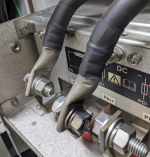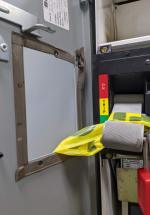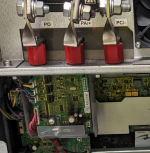drktmplr12
Senior Member
- Location
- South Florida
- Occupation
- Electrical Engineer
Vertical turbine pump
250 HP, VFD driven
Motor is 285 amps, code G, design B
VFD inside of Eaton MCC
Circuit breaker, VFD and motor all failed
Motor megged at ~7 volts each leg to ground
HMCP600L6W digitrip RMS310 set to 'H' (6,000 Amps)
Altivar-61 6W12100081 with external DC choke
No power meters available
MCP was not fully tripped
Happened during thunderstorm, South Florida
No other drives connected to same MCC impacted
No SPD on upstream switchgear or MCC
My opinion is that the motor failed and the fault cascaded to the VFD, but the the VFD did not self-protect as I would expect. The circuit breaker operated above its rating but was not set to interrupt the arcing fault current. Evidence of arcing fault can be observed on the VFD DC choke terminals and above the circuit breaker protective shroud. I believe that the VFD circuit board failed when PA/+ arced to PC/- and this caused the power flow to the motor to stop.
Interested to hear others' thoughts.
Thanks for reading


250 HP, VFD driven
Motor is 285 amps, code G, design B
VFD inside of Eaton MCC
Circuit breaker, VFD and motor all failed
Motor megged at ~7 volts each leg to ground
HMCP600L6W digitrip RMS310 set to 'H' (6,000 Amps)
Altivar-61 6W12100081 with external DC choke
No power meters available
MCP was not fully tripped
Happened during thunderstorm, South Florida
No other drives connected to same MCC impacted
No SPD on upstream switchgear or MCC
My opinion is that the motor failed and the fault cascaded to the VFD, but the the VFD did not self-protect as I would expect. The circuit breaker operated above its rating but was not set to interrupt the arcing fault current. Evidence of arcing fault can be observed on the VFD DC choke terminals and above the circuit breaker protective shroud. I believe that the VFD circuit board failed when PA/+ arced to PC/- and this caused the power flow to the motor to stop.
Interested to hear others' thoughts.
Thanks for reading







